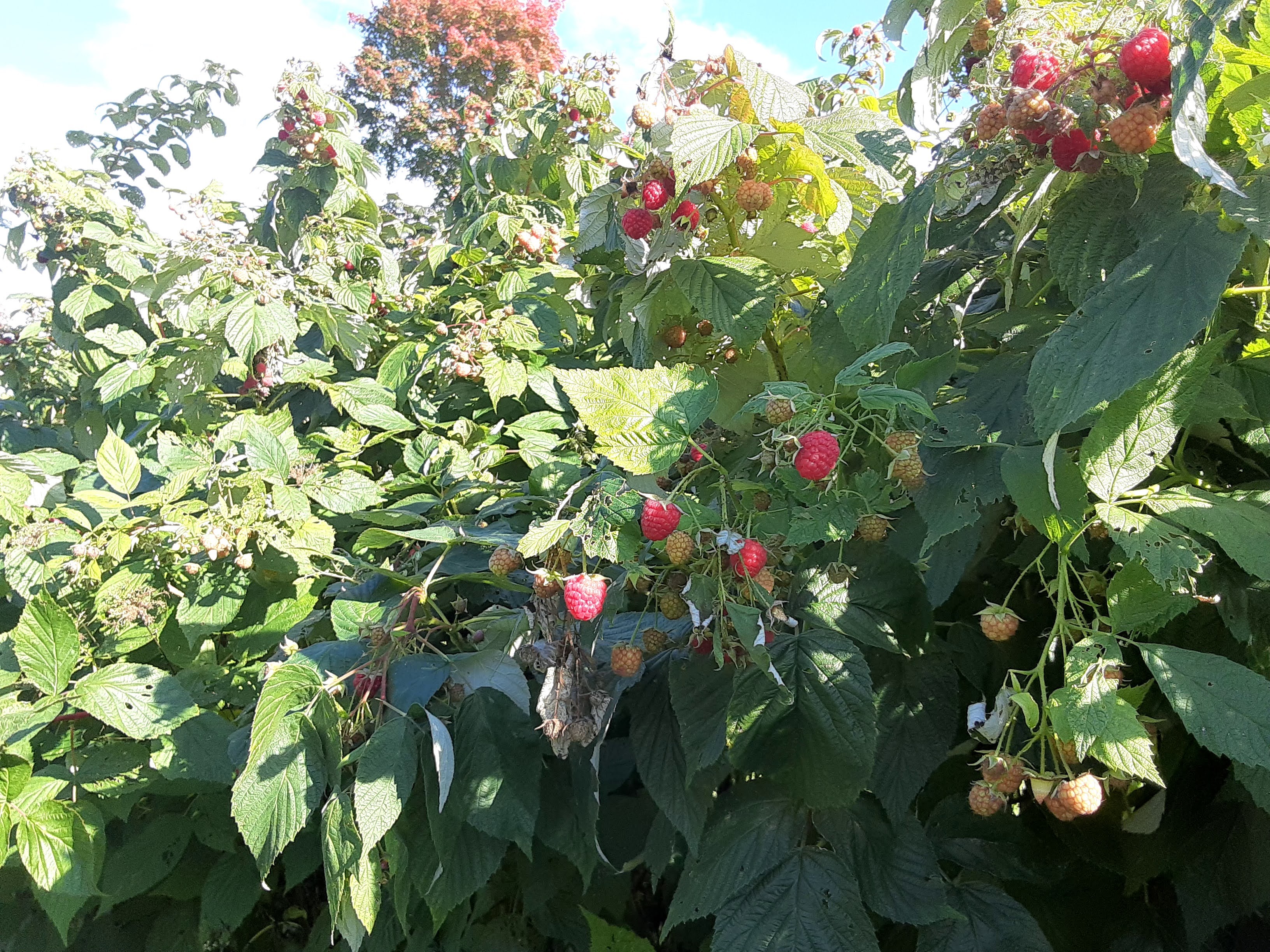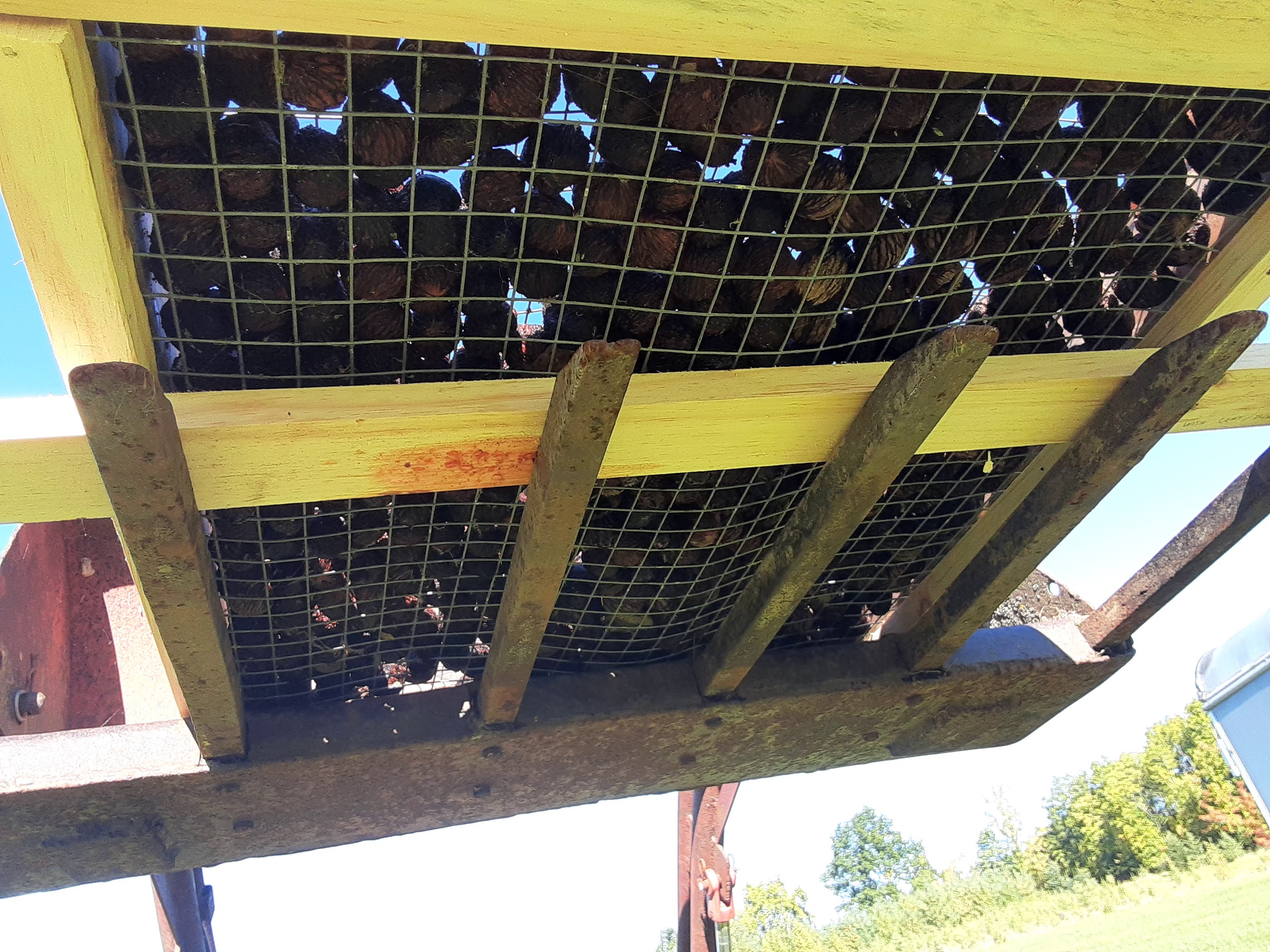Fall Raspberries and Black Walnuts
October 2, 2022
This afternoon I reluctantly took a large plastic bowl off the counter, put on my boots, hat and vest, and headed for the berry patch. This chore has been ongoing since September 2nd, a full month.
It was a beautiful, cold fall day. The loaded raspberry bushes bounced merrily around in the unaccustomed east wind, but I persevered, scooping handfuls of them into the broad, light container. The patch is a 3′ wide row, 50′ long. That’s a lot of picking, it turns out, especially late in the season when the bushes maximize their production until the frost kills them and you mow them down. Then they grow anew in the spring, only to begin the cycle again on the first of September.
The best thing about cold weather berry picking is that the insects are largely absent, (except for lady bugs today). Another tasty thing is that over-ripe berries don’t ferment the way they do in summer. Instead they turn a dark red and wait for the picker to devour their sweetness as his reward. It was a tasty afternoon, with 3 3/4 pounds of raspberries for the freezer, left over from my feast.

That’s a maple in fall colours in the background, btw.
I have written regularly in this space about my ongoing battles with red squirrels, and how I take a measure of revenge by raiding their nut caches. This year the devious little fellows relocated the cache I had such fun raiding last year. It is now 250 yards south of the other one, and somewhat better concealed. In fact, I blundered onto it by accident while trying to figure out if all of the walnut trees in the woodlot had taken the year off from nut production. In any case, I picked up six, five-gallon pails of nuts because it looked to be slim pickings this year. Even the every-year bearer at the house seems low on nuts because the neighbouring trees are barren, there are no nuts in my two, four acre nut orchards, and the five acre pine/walnut field has only one producing tree.
There must have been a late frost which caught them. Even temperatures a couple of degrees above freezing will kill the flowers. The tree at the house is protected from frost on a still night by the chimney of the furnace. Two regular-bearers back the lane are very old and tall. Their upper branches seem to miss low-lying fogs.
So in their turn I dumped four pails of nuts into my cement mixer, with streams of water and a few round stones. I borrowed my neighbour’s drying tray and prepared the extra piece of mesh to cover the nuts. In went the nuts. On went the mesh. Then I loaded the package onto the bucket of an old tractor, drove it out into an open field, and raised the loader up above my head.
The squirrels are still worried about red tails and harriers, not to mention the odd fox and coyote, all of which love a squirrel dinner. The nuts should dry in peace.

A visit to Lostwithiel Farm
November 9, 2009
When agronomist Neil Thomas is not on assignment in Africa for CIDA or helping his wife manage a vineyard and winery in southern Pennsylvania, he works on the family property near Lansdowne where they tend to acres of grapes and the area’s largest black walnut orchard.
Everyone agrees that the black walnut is the gourmet nut of choice: it has a smooth, rich flavour, complex and nuanced. Nutritionally it scores off the charts on all indicators of desirability. The only problem is getting the kernel away from the shell.
The lack of affordable processing machinery has prevented the growth of a market for black walnuts in Canada, but over the last two decades Neil has used his contacts and reputation to arrange for the development of technology to fill this need.
The latest machine to emerge from a collaboration with the Engineering Technology Department at Algonquin College is a continuous-flow nut washer.
“This invention replaces a set of five hand operations based around a cement mixer, a large screen and a pair of rubber gloves which gave me an extremely sore back last year. When Brad Thompson and a team of fellow students confronted the problem, they designed a big, shiny, three-quarter-ton beast which looks a bit like a jet engine on a test bed. So far it has not thrust me out of the barn, but we haven’t used it yet.”
Today was to be the day for the test.
First up was a trailer load of nuts from Westport. Planted in 1937, Dr. Goodfellow’s black walnut trees have proven a reliable and abundant source of fruit, and current owners John and Delcy Marchand sought Neil out as the only processor in the area.
My job was to dump the bags and tubs of walnuts onto the conveyor and regulate the feed up a stepped belt adapted from the potato industry. At the top the nuts drop into a huller, a noisy machine consisting of a large cylinder with a series of rubber pads inside set up to remove the gooey outer hull of the nuts. The hulls are forced down through a grate at the bottom as the cleaned nuts make their way out the end, down a funnel, and into a flotation trough which tests each nut’s quality. If it floats, it is discarded.
Eager to try his new toy, Neil waited impatiently as I ran the nuts through and into the trough. With a large plastic shovel he scooped the hulled nuts out of the long trough and into the hopper of the washer. He turned it on and away they went, without fuss.
The washer consists of a large, perforated, rotating drum with a slowly counter-rotating auger inside to feed the nuts along through the machine. An electronic control panel provides infinite adjustment to the rate of feed.
In five minutes John’s crop of walnuts had been washed and deposited in the rack for moving to the dryer. I commented to Neil, “Your guys certainly did a good job. That thing runs as smoothly as a Honda.”
Personally, I fancy tools that keep me on my toes, demanding all my alertness and ingenuity just to keep them working. The new washer seemed discouragingly competent to me, but Neil and his sore back just beamed.
While he prepared lunch I subjected my host to the third degree on the walnut business:
What does the black walnut tree offer to Canadian food shoppers?
Black walnut is the truffle of the tree-nut world. The nut meat is rich, with a creamy texture and often pungent flavours. This means that far less can be used in cooking and you get a lot of taste for a few calories. There is less fat and more protein in black walnuts than in other nuts. Pastry chefs cherish them for their outstanding contribution to fine cuisine.
People are prepared to pay far more for black walnut products than for other nut types.
Why don’t more people plant black walnut trees?
Farmers in this area have spent two hundred years removing trees from their fields, and don’t want to put them back. There’s also the long product cycle. In fact, though, ordinary black walnut trees should produce nuts by the time they are twelve years old, a far shorter interval than growing trees for timber.
Can you make money from black walnuts?
I believe you can, because we have test-marketed kernel at $1.00 per ounce, far more than consumers are willing to pay for other nut types. We couldn’t keep up with the demand.
What will it take to make black walnut production a successful industry in this area?
It will take a critical mass of rural landowners establishing plantations so that we can sustain production with locally-produced nuts.
Separating out the edible kernel is really the challenge. Nobody wants chunks of shell in their muffins or their ice cream, so most of our technology development emphasis is on the machinery to crack and separate. In Missouri the Hammond Company uses a very expensive optical sorting operation which nobody can afford at the farm scale. So we need to find the trick of separating kernel and shell by a cheaper mechanical means and this is where most of our emphasis goes.